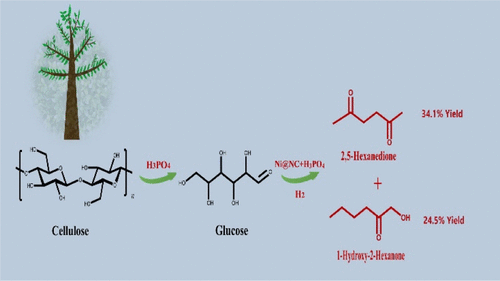当前位置:
X-MOL 学术
›
ACS Sustain. Chem. Eng.
›
论文详情
Our official English website, www.x-mol.net, welcomes your
feedback! (Note: you will need to create a separate account there.)
Selective Cellulose Hydrogenolysis to 2,5-Hexanedione and 1-Hydroxy-2-hexanone Using Ni@NC Combined with H3PO4
ACS Sustainable Chemistry & Engineering ( IF 7.1 ) Pub Date : 2021-11-08 , DOI: 10.1021/acssuschemeng.1c03858 Yuan Liang 1, 2 , Haiyong Wang 2 , Haosheng Xin 2 , Xiaohong Hu 2 , Long Yan 2, 3 , Qi Zhang 2, 3 , Chenguang Wang 2, 3 , Qiying Liu 2, 3, 4 , Longlong Ma 1, 2, 3
ACS Sustainable Chemistry & Engineering ( IF 7.1 ) Pub Date : 2021-11-08 , DOI: 10.1021/acssuschemeng.1c03858 Yuan Liang 1, 2 , Haiyong Wang 2 , Haosheng Xin 2 , Xiaohong Hu 2 , Long Yan 2, 3 , Qi Zhang 2, 3 , Chenguang Wang 2, 3 , Qiying Liu 2, 3, 4 , Longlong Ma 1, 2, 3
Affiliation

|
The production of ketones from cellulose is critical but challenging due to the easy hydrogenation of ketone groups. Herein, Ni particles encapsulated in N-doped carbon layers (Ni@NC) were synthesized and used as efficient catalysts for direct cellulose hydrogenolysis to 2,5-hexanedione (HD) and 1-hydroxy-2-hexanone (HHO) in H3PO4 aqueous solution. HD and the first reported HHO in this work could be simultaneously produced with the yields of 34.1% and 24.5%, respectively. It was found that the hydrolyzed glucose was the key intermediate in the formation of these two target products. HD originated from the hydrolysis of 2,5-dimethylfuran (2,5-DMF) that was produced via glucose (from cellulose hydrolysis catalyzed by H3PO4) isomerization to fructose, followed by fructose dehydration to 5-hydroxymethylfurfural (5-HMF) and 5-HMF hydrodeoxgenation. In parallel, HHO was obtained from the selective hydrodeoxygenation of hexoses. The N species of Ni@NC catalysts acted as the basic sites for promoting glucose isomerization to fructose. The production of ketones could be attributed to the tailored hydrogenation ability of Ni@NC, which facilitated the selective preservation of C═O bonds. The synergy between H3PO4 (cellulose hydrolysis and C–O bond splitting by hydrogenolysis), base (aldehyde isomerization to ketone), and metallic Ni (hydrogenation) played an essential role in the formation of ketone-containing products with high yields.
中文翻译:

使用 Ni@NC 与 H3PO4 选择性地将纤维素氢解为 2,5-己二酮和 1-羟基-2-己酮
由于酮基容易氢化,从纤维素生产酮是关键但具有挑战性的。在此,合成了封装在 N 掺杂碳层 (Ni@NC) 中的 Ni 颗粒,并将其用作在 H 3中将纤维素直接氢解为 2,5-己二酮 (HD) 和 1-羟基-2-己酮 (HHO) 的有效催化剂PO 4水溶液。HD 和这项工作中首次报道的 HHO 可以同时生产,产率分别为 34.1% 和 24.5%。发现水解葡萄糖是形成这两种目标产物的关键中间体。HD 源于通过葡萄糖产生的 2,5-二甲基呋喃 (2,5-DMF) 的水解(来自 H 3 PO 4催化的纤维素水解)) 异构化为果糖,然后果糖脱水为 5-羟甲基糠醛 (5-HMF) 和 5-HMF 加氢脱氧。同时,HHO 是从己糖的选择性加氢脱氧中获得的。Ni@NC催化剂的N种作为促进葡萄糖异构化为果糖的基本位点。酮的产生可归因于 Ni@NC 的定制氢化能力,这促进了 C=O 键的选择性保存。H 3 PO 4(纤维素水解和氢解C-O键分裂)、碱(醛异构化为酮)和金属Ni(氢化)之间的协同作用在高产率的含酮产物的形成中发挥了重要作用。
更新日期:2021-11-22
中文翻译:

使用 Ni@NC 与 H3PO4 选择性地将纤维素氢解为 2,5-己二酮和 1-羟基-2-己酮
由于酮基容易氢化,从纤维素生产酮是关键但具有挑战性的。在此,合成了封装在 N 掺杂碳层 (Ni@NC) 中的 Ni 颗粒,并将其用作在 H 3中将纤维素直接氢解为 2,5-己二酮 (HD) 和 1-羟基-2-己酮 (HHO) 的有效催化剂PO 4水溶液。HD 和这项工作中首次报道的 HHO 可以同时生产,产率分别为 34.1% 和 24.5%。发现水解葡萄糖是形成这两种目标产物的关键中间体。HD 源于通过葡萄糖产生的 2,5-二甲基呋喃 (2,5-DMF) 的水解(来自 H 3 PO 4催化的纤维素水解)) 异构化为果糖,然后果糖脱水为 5-羟甲基糠醛 (5-HMF) 和 5-HMF 加氢脱氧。同时,HHO 是从己糖的选择性加氢脱氧中获得的。Ni@NC催化剂的N种作为促进葡萄糖异构化为果糖的基本位点。酮的产生可归因于 Ni@NC 的定制氢化能力,这促进了 C=O 键的选择性保存。H 3 PO 4(纤维素水解和氢解C-O键分裂)、碱(醛异构化为酮)和金属Ni(氢化)之间的协同作用在高产率的含酮产物的形成中发挥了重要作用。

































 京公网安备 11010802027423号
京公网安备 11010802027423号